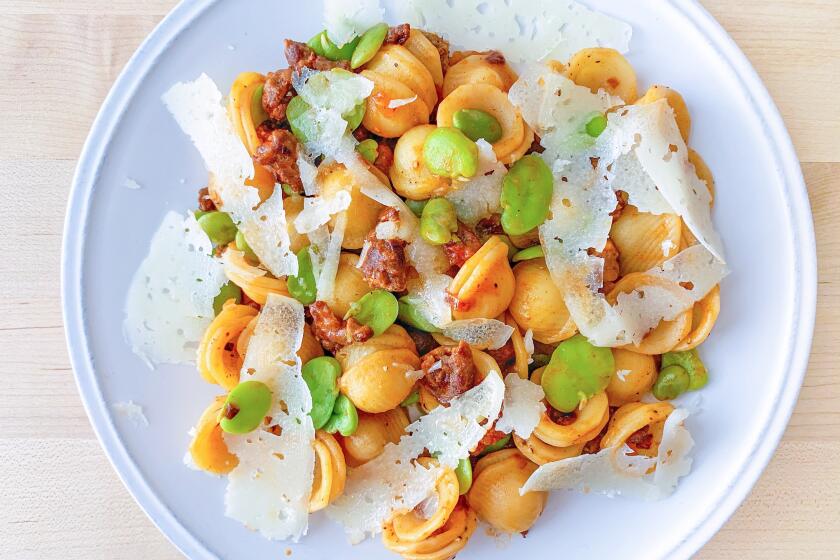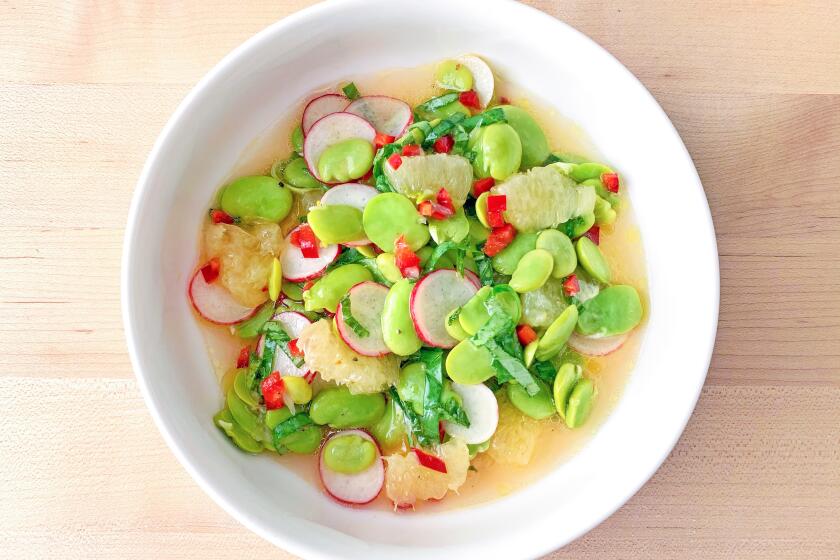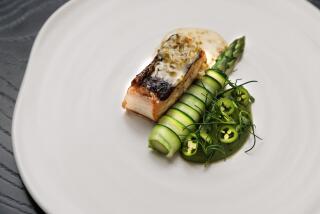Getting the most out of cooking with fresh fava beans
When it comes to dealing with precious spring produce in California, the less you do to it, the better. And that M.O. sustains because the produce’s unique freshness and flavor are fleeting and so wonderful here. New asparagus, potatoes, baby artichokes and oddities like fiddlehead ferns or garlic scapes beg to be gently cooked, then drizzled with olive oil and sprinkled with salt, doing the bare minimum to highlight their flavor.
When it comes to fresh fava beans, however, it’s much easier to keep the party going all year long. My upbringing in a zipper cream pea field in Mississippi prepared me for dealing with these types of fresh legumes and taught me how to keep their freshness intact, even in the deep chill of the garage freezer.
The harvest of zipper cream peas — a particular type of creamy-textured legume related to black-eyed peas — came in July when the late-summer heat and humidity in Mississippi would melt the skin off your bones. At my grandparents’ farm 10 miles outside of town, my father would hand me a 10-gallon bucket and say, “You’re done when you fill it to the top.” Eleven months of memory suppression would leave me feeling confident I could fill the bucket quickly. In actuality, the task took a solid eight to 10 hours of bending over and picking pods off prickly, wasp- and spider-swarmed rows of plants.
The next day, though, as a reward for dealing with the previous day’s heatstroke, we’d sit in our air-conditioned living room and literally “zip” the pods open with our thumbs — hence their name — and let the beans inside topple into giant bowls in our laps. We’d then sort through the peas, making sure to toss any rotten or imperfect specimens.
Later that night, my mom would fill with water a pot large enough to take a bath in and bring it to a boil on the stove. Batch by batch, the peas would be blanched, then drained, cooled and piled into plastic bags. From there, they’d go to the deep-freeze in the garage, readily available for a whole year’s worth of dinners.
It was this division of labor that made me look at favas and the task of peeling and preparing them with fondness (while my soul fills with dread at the thought of turning an artichoke, which has to be done all at once). Although preparing fresh fava beans can be tedious, the ability to freeze and enjoy them all year makes the task worth it.
Similar to those peas — we’d always eat the first few batches with reverence, flavored simply with some rendered bacon fat or butter and served with cornbread — the first meals with fava beans I make are typically nothing more than the beans warmed in olive oil used to crisp prosciutto or speck. Beans and pork fat are an enduring pairing for a reason.
The best way to peel and prep them for the freezer so they can be used whenever you want them.
After a while, even that starts getting old and I’m ready for something new. This year, I’ve got two more daring approaches, both of them dreamed up by my partner, J., another fava fan.
The first uses favas as a stand-in for fish in a ceviche-like salad. Fresh fava beans — sweet, clean, toothsome — are mixed with some last-of-the-season white Marsh grapefruit or pomelo segments and their juice, some olive oil and speckles of minced red chile and fresh mint and basil. Like traditional fish ceviche, the beans get better the longer they sit in the tonic, lightly pickling themselves and absorbing the bitter, tart, spicy, herbal flavors. You can eat it on a tostada to mimic real ceviche, but I eat it with a spoon out of the container from the fridge for a refreshing, no-dishes-to-wash lunch.
The second is a simple pasta dish inspired by the western Mediterranean. Merguez from Morocco — a slightly gamey lamb sausage that’s just-spicy-enough to command notice but not overwhelm your senses — is a great pairing for the mild but still assertive fava beans, tossed with orecchiette and caramelized shallots. The whole dish is topped with shavings of manchego from Spain — a cheese often relegated to cheese boards but one whose sheep’s milk funk plays off the sausage and creamy beans brilliantly.
So, buy all the fava beans you can now and spend a day peeling and blanching them (a soothing, meditative exercise if you ask me) because once you have your freezer stocked with them, you’ll find plenty of ways to enjoy them — both simple and more involved — that put their unique flavor to good use and let you cash in on all that work that got them to your fork.
Get the recipes:
Fresh Fava and Merguez Orecchiette With Manchego
Fresh Fava “Ceviche” With Grapefruit and Chilies
More to Read
Eat your way across L.A.
Get our weekly Tasting Notes newsletter for reviews, news and more.
You may occasionally receive promotional content from the Los Angeles Times.










